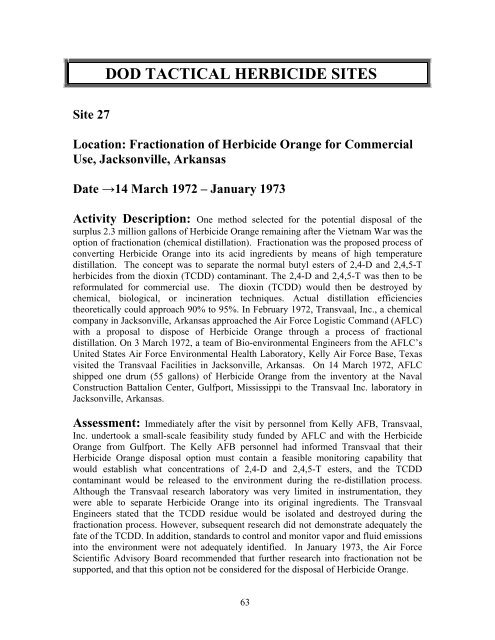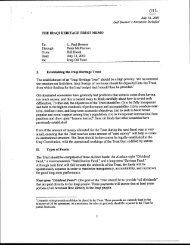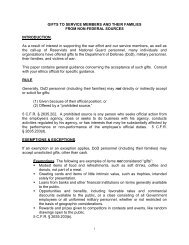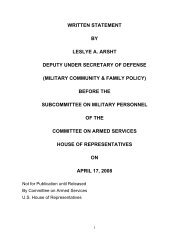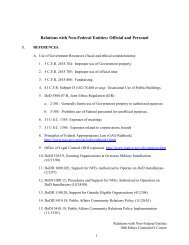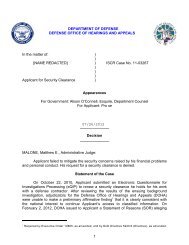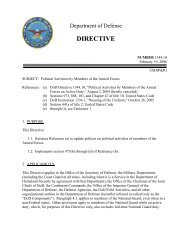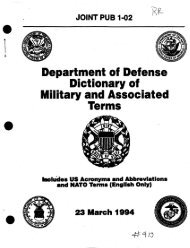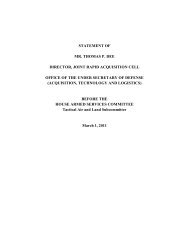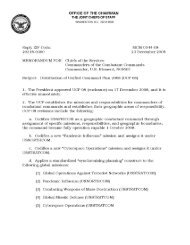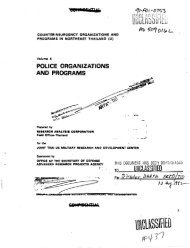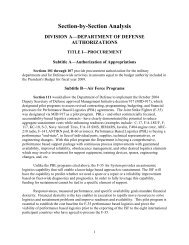dod tactical herbicide sites - United States Department of Defense
dod tactical herbicide sites - United States Department of Defense
dod tactical herbicide sites - United States Department of Defense
You also want an ePaper? Increase the reach of your titles
YUMPU automatically turns print PDFs into web optimized ePapers that Google loves.
DOD TACTICAL HERBICIDE SITESSite 27Location: Fractionation <strong>of</strong> Herbicide Orange for CommercialUse, Jacksonville, ArkansasDate →14 March 1972 – January 1973Activity Description: One method selected for the potential disposal <strong>of</strong> thesurplus 2.3 million gallons <strong>of</strong> Herbicide Orange remaining after the Vietnam War was theoption <strong>of</strong> fractionation (chemical distillation). Fractionation was the proposed process <strong>of</strong>converting Herbicide Orange into its acid ingredients by means <strong>of</strong> high temperaturedistillation. The concept was to separate the normal butyl esters <strong>of</strong> 2,4-D and 2,4,5-T<strong>herbicide</strong>s from the dioxin (TCDD) contaminant. The 2,4-D and 2,4,5-T was then to bereformulated for commercial use. The dioxin (TCDD) would then be destroyed bychemical, biological, or incineration techniques. Actual distillation efficienciestheoretically could approach 90% to 95%. In February 1972, Transvaal, Inc., a chemicalcompany in Jacksonville, Arkansas approached the Air Force Logistic Command (AFLC)with a proposal to dispose <strong>of</strong> Herbicide Orange through a process <strong>of</strong> fractionaldistillation. On 3 March 1972, a team <strong>of</strong> Bio-environmental Engineers from the AFLC’s<strong>United</strong> <strong>States</strong> Air Force Environmental Health Laboratory, Kelly Air Force Base, Texasvisited the Transvaal Facilities in Jacksonville, Arkansas. On 14 March 1972, AFLCshipped one drum (55 gallons) <strong>of</strong> Herbicide Orange from the inventory at the NavalConstruction Battalion Center, Gulfport, Mississippi to the Transvaal Inc. laboratory inJacksonville, Arkansas.Assessment: Immediately after the visit by personnel from Kelly AFB, Transvaal,Inc. undertook a small-scale feasibility study funded by AFLC and with the HerbicideOrange from Gulfport. The Kelly AFB personnel had informed Transvaal that theirHerbicide Orange disposal option must contain a feasible monitoring capability thatwould establish what concentrations <strong>of</strong> 2,4-D and 2,4,5-T esters, and the TCDDcontaminant would be released to the environment during the re-distillation process.Although the Transvaal research laboratory was very limited in instrumentation, theywere able to separate Herbicide Orange into its original ingredients. The TransvaalEngineers stated that the TCDD residue would be isolated and destroyed during thefractionation process. However, subsequent research did not demonstrate adequately thefate <strong>of</strong> the TCDD. In addition, standards to control and monitor vapor and fluid emissionsinto the environment were not adequately identified. In January 1973, the Air ForceScientific Advisory Board recommended that further research into fractionation not besupported, and that this option not be considered for the disposal <strong>of</strong> Herbicide Orange.63


